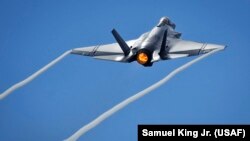International deliveries of arms were flat from 2016 through 2020 compared with the previous five-year period, but they were still close to the highest level since the end of the Cold War, the Stockholm International Peace Research Institute (SIPRI) said in a report released on March 15.
Three of the top five arms exporters -- the United States, France, and Germany -- increased deliveries from 2016 to 2020, but a decline in exports from Russia and China offset the rise, SIPRI said in its latest review of global arms transfers.
It was the first time since the 2001-05 period that the volume of deliveries of major arms between countries did not increase from the previous five years, SIPRI said.
The United States remained the top exporter, accounting for 37 percent of global arms transfers during the period, SIPRI said. Half of U.S. transfers were made to the Middle East.
Russia, the world's second-largest exporter, accounted for one-fifth of global arms deliveries, but its sales declined by 22 per cent compared to the 2011-15 period, mainly due to a sizeable drop in imports by India, SIPRI said.
SIPRI senior researcher Pieter Wezeman said it was too early to tell whether the slowdown in arms deliveries would continue.
Impact Of Pandemic
"The economic impact of the COVID-19 pandemic could see some countries reassessing their arms imports in the coming years," Wezeman said. "However, at the same time, even at the height of the pandemic in 2020, several countries signed large contracts for major arms."
The United Arab Emirates, for example, recently signed an agreement with the United States to purchase 50 F-35 jets and up to 18 armed drones as part of a $23 billion package.
Middle Eastern countries accounted for the biggest increase in arms imports, up 25 percent in 2016–20 from 2011–15.
Saudi Arabia was the world's largest arms importer, accounting for 11 per cent of global imports during the period. Other top importers were India, Egypt, Australia, and China.
Asia and Oceania were the largest importing regions for major arms, receiving 42 percent of global arms transfers in 2016–20. India, Australia, China, South Korea, and Pakistan were the biggest importers in the region.
France, the third largest exporter, with 8 percent, recorded several large deals, most notably with India, Egypt, and Qatar, the institute said.
Germany and China completed the list of top five exporters.
The SIPRI arms transfers database does not include small arms and is based on public sources, including newspapers, specialized international journals, and government and industry reports.
